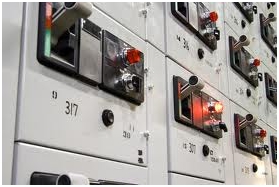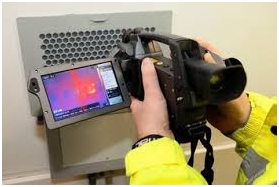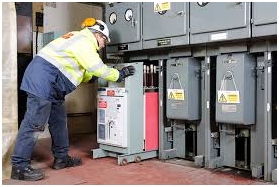Eric S., one of the readers of the blog sent us an article in which he gives information on how to inspect, test and measure low and medium voltage switchgears. But first, he starts with few words on the importance of these checks and maintenance.
Enjoy and don’t forget you can send us your articles by mail.
Importance of routine checks and regular maintenance
If switchgears are installed in well ventilated, air-conditioned and clean environmental conditions, they do not require much maintenance.
Major inspections are needed and are done only during plant shut downs. These inspections include contact wear identification, checking on interlock operations, observing overload settings, size of the fuses employed, overheating and finally, checking if there is any dirt or corrosion in the switchgear components.
In case of medium voltage switchgears, more concentration should be placed on checking the protective devices, oil levels in the circuit breaker and contact distances of the vacuum bottles and see if they are as per the manufacturer’s specifications.
Note 1: Exemptions in maintenance schedule are given to the switchgears that operate frequently, whose maintenance depends on the total number of operational hours.
Note 2: Even after clearing short circuit tests, care should be taken that medium voltage switchgear insulation and contactual circuits are intact, and fit for further use.
Note 3: Another exemption is, gas insulated switchgear, which is only to be maintained as per manufacturer’s specifications. If any extensive maintenance is required, it is recommended that it should be done under the supervision of the manufacturer.
Note 4: In case of aged switchgear, conditional assessment is to be made in order to find out if the devices are fit for further operation.
How to inspect, test and measure low voltage switchgear?
Let us now see how to inspect the various components, how often do they need inspection and what kind of inspections are needed for both LV and MV switchgear.
Inspection and maintenance:
- General inspection – every year – all components
- Motor and starter windings, feeders (outgoing), incomers – every four years
- Compartments of busbars – every eight years
- Voltmeter correctness – every four years
- Ammeter correctness – every four years
- Outdoor equipment conditional assessment – every two years
Testing and Maintenance:
Feeders (incoming), busbars, switches
- Operating systems, interlocks, controlling equipment, protection equipment – every four years
Busbar systems
- Bolts for torque resistance, insulation resistance, ductors – every eight years
Feeders of the motor
- Draw out interlocks and cable tightness – every four years
- Thermal fault protection and earth fault – every four years
- Category ‘e’ thermal protection – every 3 years
- Restarting – every four years
- Insulation resistance – every four years
Feeders (Plain)
- Draw out interlocks, cable tightness – every four years
- Tripping – every four years
- R.C.D on a fixed load (to test overheating) – every four years
How to inspect, test and measure medium voltage switchgear?
Inspection and maintenance
- General inspection – every year – all components
- Internal cable boxes, internal CB’s, internal fuse contactors – every four years
- Compartments of busbars – every eight years
- Voltmeter correctness – every four years
- Ammeter correctness – every four years
- Other measuring systems – every four years
Testing and Maintenance:
- Operating systems, interlocks, controlling equipment, protection equipment – every four years
- Dielectric strength – every eight years
- Ductor test – every four years
- Category ‘e’ thermal protection – every 3 years
- Distance between the contacts (Vacuum, SF6) – every four years
- Dielectric oil test (oil-immersed) – every four years
- Insulation resistance – every four years
- Restarting – every four years
Busbar systems
- Bolts for torque resistance, insulation resistance, doctors and dielectric strength – every eight years
- Checking correctness of kW, kVAr and measuring system’s maximum demands – every four years
Restoration
- Greasing all components of the equipment – every four years
- Oil filtering and replacement, and replacing the components – as and when necessary
Conclusion
Following the above procedures and maintenance schedule for your plant’s light and medium switchgears, will ensure optimum performance and long life. However, when conducting certain tests, such as infrared scanning, care should be taken to see that the metallic housings are removed before conducting tests.
I agree that this can be dangerous, as these housings have to be removed when the system is still hot. But, for effective testing and maintenance of the switch gear, and to ensure proper operation of the plant, certain risks have to be taken.
However, following proper safety measures, wearing safety gear and using double insulated devices, can considerably reduce the risks, if not completely eliminate them.
Do you agree with these information? Can you tell us your own experience?



i need to routine checks and regular maintenance format log sheet ( rules BNBC)
Do not attempt to work on your electrical wiring, switches, or outlets unless you are properly trained and equipped to do so. Electrical components in a building can easily cause an electrical shock, burn, or even death. Thanks for the following useful blog.
Thanks for the information. I had no idea that regular maintenance of switchgears could be so beneficial! Now that you mention it though, I can see that not doing so could really end up hurting the machinery. I’m going to make sure mine is inspected on a regular basis.
Please mention the procedure for injection tests for AIR circuit breaker